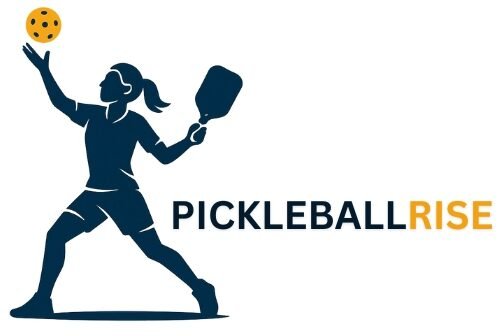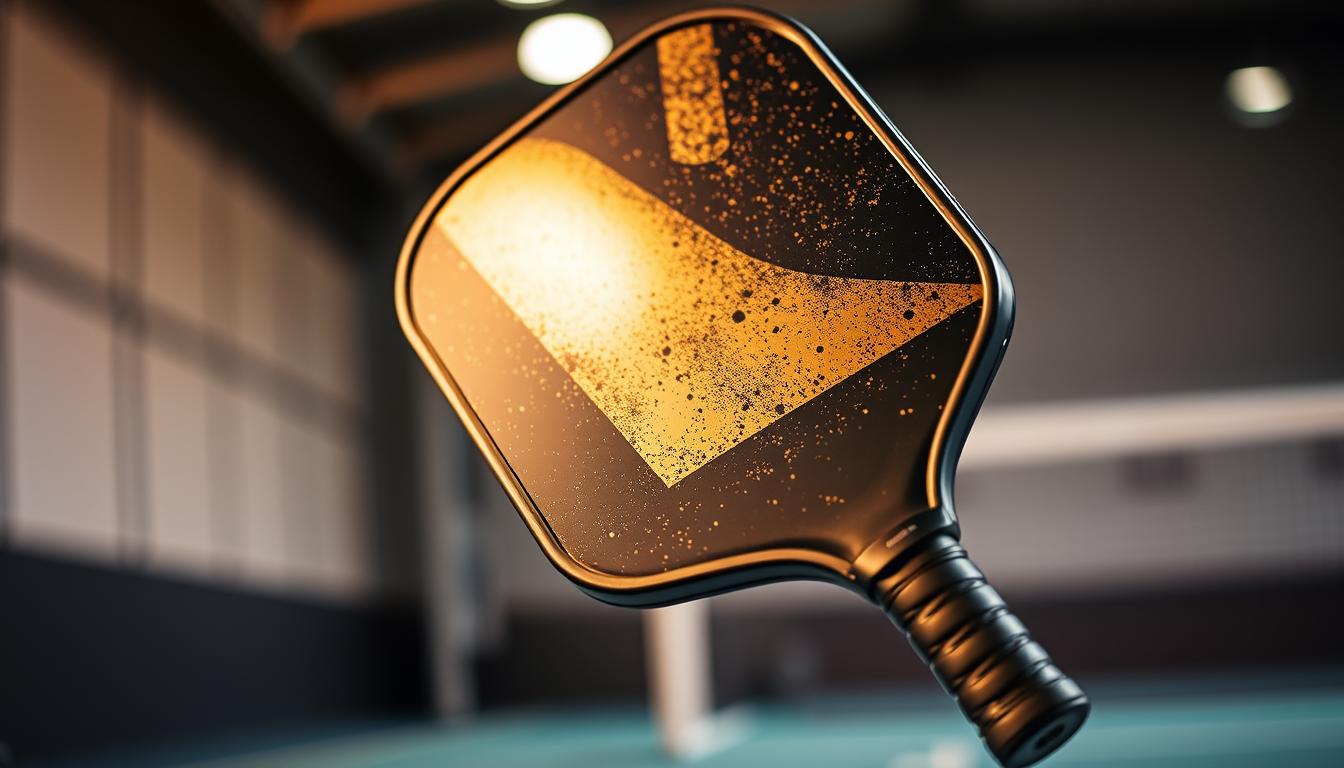7 Best Beginner Pickleball Paddle Basics Every Player Must Know
Do you remember your first time holding a paddle? It felt light and curious. You wondered if you were holding the right tool for the game. Whether you played tennis before or are new to the court, your paddle affects how fast you learn and enjoy playing.
This guide is here to help you cut through the marketing noise from big brands like Selkirk, Paddletek, and Onix. We’ll show you what really matters when choosing a beginner pickleball paddle that helps you grow your skills faster. With so many brands and models out there, learning to read a spec sheet can save you time and trouble.
We’ll teach you how to choose the right beginner pickleball paddle by focusing on key features — including material, thickness, shape, facing layups, and weight. We’ll also explain static weight, swingweight, and twistweight, so you can understand how each detail affects performance.
By the end of this guide, you’ll know which specs to trust and which marketing terms to ignore. Your next beginner pickleball paddle purchase will actually improve your game, not slow it down.
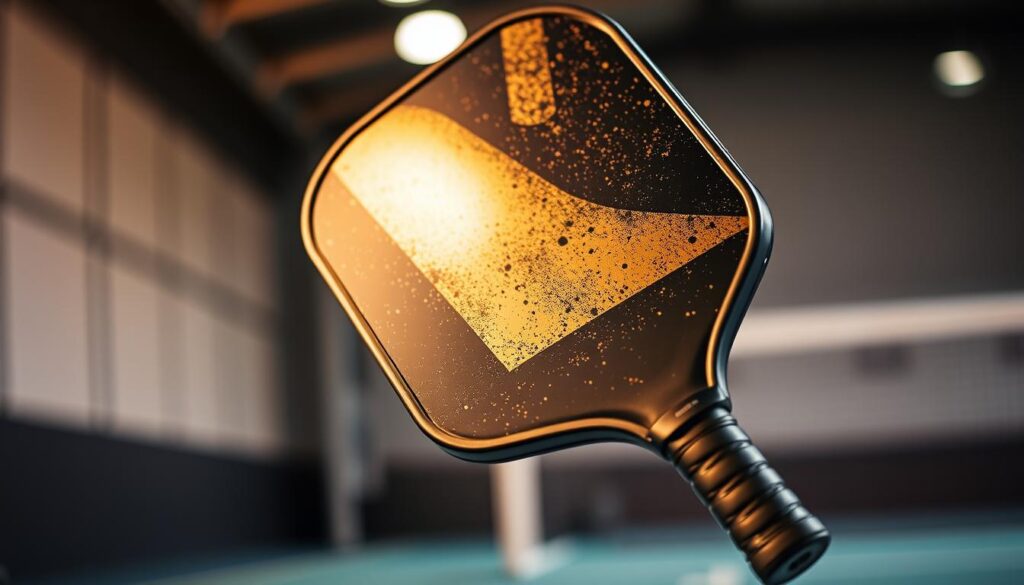
Why Your Paddle Choice Matters for New Players
Your first paddle is key to learning fast and enjoying the game. A heavy, head-heavy, or small-sweet-spot paddle can make it hard to be consistent. It might also make you tired quickly or develop bad habits.
On the other hand, a paddle that favors control and forgiveness will help your rallies last longer. You’ll find practice more productive, and you’ll progress faster.
How paddle selection affects learning speed and enjoyment
Light paddles under 8 oz help you react faster at the net. This means you can improve your volley timing sooner. Midweight paddles offer a balance of pop and control, which is great for practicing drives and dinks.
Heavier paddles add raw power but can slow down your reaction time. This can shorten your practice sessions because your arm gets tired faster.
Common beginner problems tied to the wrong paddle
A grip size that’s too large or too small can reduce feel and increase the risk of wrist or elbow pain. A very heavy paddle causes swing fatigue, cutting down practice time and slowing improvement.
Elongated or head-heavy shapes can make mishits worse because they reduce forgiveness. A tiny sweet spot leads to more off-center shots and uneven returns.
What to prioritize first: control, forgiveness, or power?
When you start, prioritize control and forgiveness. A larger sweet spot and a stable, predictable feel reduce errors. This encourages longer practice.
Power is less important at first. Modern paddles from brands like Selkirk and Paddletek offer enough pop without sacrificing forgiveness. Choose a model that protects your arm and lowers your error rate. This way, you can play more and learn faster.
This beginner-friendly pickleball paddle guide helps you focus on what matters most. Look for the best beginner pickleball paddle that offers stability and a forgiving face. With the right choice, you’ll enjoy playing more, practice longer, and see your skills improve quickly.
Understanding Paddle Weight and Swingfeel
Pickleball paddle weight affects how your arm feels and how the paddle performs. You need a paddle that matches your strength and playing style. This guide explains static weight, swingweight, and twistweight to help you choose the right paddle.
Static weight ranges and what they mean for your arm
Static weight is the paddle’s weight on a scale. Light paddles weigh less than 7.5–7.8 oz. They help you move quickly and reduce arm fatigue.
Midweight paddles weigh 7.5–8.3 oz. They offer a good balance of control and power. Heavy paddles, over 8.3 oz, provide more power but can tire you.
For beginners, a weight between 7.3–8.3 oz is ideal. It helps you learn shots without injury.
Swingweight and twistweight explained in plain terms
Swingweight shows how hard the paddle is to swing. Higher values mean more power behind your shots. Aim for 112–118 for a balanced swing.
Twistweight affects how the paddle handles off-center hits. More twistweight means a larger sweet spot. Look for a twistweight above 6 for forgiving play.
Recommended weight ranges for most beginners and why
When comparing paddles, focus on these ranges. Aim for static weight of 7.3–8.3 oz, swingweight of 112–118, and twistweight above 6. These help you learn control and avoid fatigue.
Paddle shape also matters. Elongated paddles have higher swingweight and lower twistweight. Widebody designs have lower swingweight and higher twistweight, making them more stable for beginners.
| Metric | Typical Range | What it means for you | Beginner target |
|---|---|---|---|
| Static weight | Light <7.5–7.8 oz, Mid 7.5–8.3 oz, Heavy >8.3 oz | Speed vs power and arm fatigue | 7.3–8.3 oz |
| Swingweight | 100–140 | Resistance to swinging; higher = more power | ~112–118 |
| Twistweight | 5–8 | Resistance to twisting; higher = more forgiveness | >6 |
| Shape impact | Elongated vs widebody | Elongated: higher swingweight, lower twistweight. Widebody: opposite. | Choose widebody for stability if you’re unsure |
When looking for a beginner paddle, use these numbers. Try paddles on-court to feel swingweight and twistweight. This hands-on approach helps you find a paddle that reduces strain and boosts control and confidence.
Core Materials and Core Thickness for Beginner-Friendly Play
Choosing the right core can change how your paddle feels on every shot. This part of your beginner pickleball paddle guide explains the two main core families. It also talks about how thickness affects forgiveness, pop, and the sweet spot. Read each short paragraph and use the points to compare paddles on spec sheets.
Polymer (honeycomb) cores vs foam cores: feel, durability, and 2025 updates
Polymer honeycomb cores have been dominant for years. They use cells and wall thickness to tune rebound and control. Larger cells tend to add pop and power. Smaller cells give a denser feel and steadier response.
Reviewers often note that polymer core density and cell wall thickness matter more than listed specs. Brands such as Selkirk and Onix offer honeycomb paddles that vary noticeably in that unseen structure. You will find that two paddles both labeled “polymer” can feel quite different on volleys and dinks.
Full foam cores surged in 2025 and changed expectations. Models like CRBN TruFoam demonstrate a softer impact feel and stronger long-term shape retention. Foam cores can reduce shock and preserve the sweet spot longer than many polymer honeycombs.
How 14mm vs 16mm core thickness changes forgiveness, pop, and sweet spot
Thickness is an easy spec to use when you are deciding between paddles. A 16mm core produces more forgiveness, larger sweet spot, and damped vibration. That makes a beginner-friendly pickleball paddle feel more forgiving on off-center hits.
By contrast, a 14mm core gives firmer feedback and more pop. You gain offensive options at the net and on drives. That makes 14mm paddles attractive if you want quicker pace control, but you trade some stability and shock absorption.
Most players do not need cores thicker than 16mm. Anything above that adds weight and bulk without clear on-court benefits for new players.
Why core material and thickness are top priorities when comparing spec sheets
When you read a spec sheet, ignore marketing blurbs and focus on core type and thickness first. These two choices shape your paddle’s feel far more than listed face material or graphic finish. The beginner pickleball paddle core and thickness define initial comfort, learning curve, and injury risk.
Use this guide to ask targeted questions during testing. Ask about foam density or honeycomb cell size if the maker publishes it. If not, rely on trusted reviews and on-court feel to decide which beginner-friendly pickleball paddle matches your game.
| Core Type | Typical Thickness | Feel | Durability Notes |
|---|---|---|---|
| Polymer honeycomb (common) | 14mm–16mm | Variable: firmer with smaller cells, more pop with larger cells | Proven track record; cell walls and density affect longevity |
| Full foam (Gen 4, 2025) | 14mm–16mm | Softer impact, muted vibration, consistent feel over time | Better shape retention; differences depend on foam density |
| 16mm (recommended for many beginners) | 16mm | High forgiveness, larger sweet spot, reduced shock | Offers comfort for extended play and learning |
| 14mm (for players seeking pop) | 14mm | Firmer, quicker response, more offensive potential | Smaller sweet spot; needs better technique to exploit |
Paddle Shape and How It Impacts Control and Reach
When picking a paddle, shape is key. It affects how far you can hit, the size of the sweet spot, forgiveness, and feel during swings. The USAPA rules limit paddles to 24 inches in length and width.
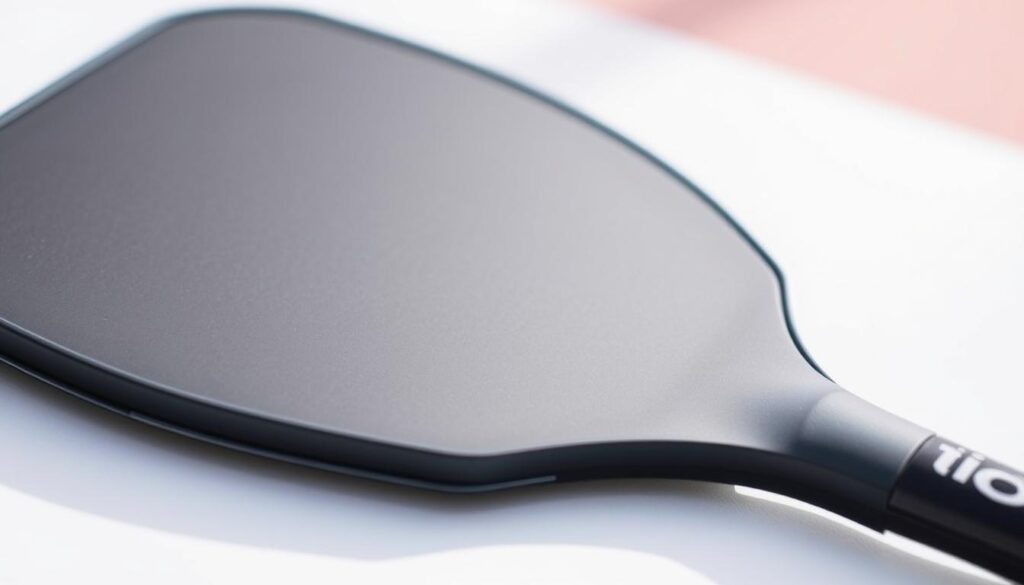
Widebody, hybrid, and elongated shapes: tradeoffs for beginners
Widebody paddles are about 16″ x 8″. They have a big hitting area and balanced feel. This makes them great for control at the net.
Hybrid paddles are around 16.25″ x 7.5–7.7″. They offer a good balance between reach and forgiveness. They’re perfect for players who need a paddle for both dinks and baseline shots.
Elongated paddles are 16.5″ x 7.5″ or longer. They give you more reach and can add power and spin. But, they have a smaller sweet spot and demand precise contact.
Sweet spot size, reach, and forgiveness by shape
Widebody paddles have the largest sweet spots and are the most forgiving. This means you’ll hit the ball more often and feel steady on volleys.
Hybrid paddles have a decent sweet spot and a bit more reach. This balance is great for quick plays.
Elongated paddles offer the most reach but are less forgiving. If you hit the ball slightly off, you’ll feel more vibration and have less control.
Why most beginners benefit from widebody or hybrid shapes
Beginners usually want control and consistency. Widebody and hybrid paddles are easier to swing and feel stable. They also have enough power, so you don’t need the extra reach of elongated paddles.
When comparing beginner pickleball paddles, look at how forgiving they are. The best paddle for beginners usually has a wide or hybrid shape. This helps reduce mishits and speeds up learning.
| Shape | Typical Dimensions | Primary Advantage | Common Drawback | Who Should Consider It |
|---|---|---|---|---|
| Widebody | ~16″ x 8″ | Large sweet spot, high forgiveness | Less reach on deep shots | Beginners focused on control and consistency |
| Hybrid | ~16.25″ x 7.5–7.7″ | Balanced reach and forgiveness | Moderate compromise between power and sweet spot | Players who want one versatile paddle |
| Elongated | ~16.5″ x 7.5″+ | Extra reach and potential power/spin | Smaller sweet spot, less forgiving | Advanced players seeking power and extension |
Facing Materials and Layups: Control, Power, and Spin
Choosing the right face material changes how your paddle feels. Carbon fiber offers a big sweet spot and steady control. Many players like this in beginner pickleball paddle reviews.
Fiberglass paddles have more pop and raw power. But, they can feel less forgiving on short punches.
Kevlar is in between carbon and fiberglass. It gives a slightly more powerful response while keeping control. Titanium-style polyester weaves, introduced in 2024, offer a softer impact and less pop. This helps players focused on placement.
Layup order affects how the paddle feels during mid-stroke and big swings. A CCC stack leans towards control and widens the sweet spot. CCF blends carbon’s control with fiberglass power for strong swings. CFC gives easier access to pop while keeping control for shorter strokes.
Brands mix layers to tune how a paddle interacts with the core and shape. This interaction is often mentioned in beginner pickleball paddle reviews. Testing different layup styles helps find the right feel for you.
Surface grit and micro-texture change spin and wear. More aggressive grit boosts spin but wears out faster. Companies like PIKKL offer replaceable skins to renew grit and extend paddle life. Think about longevity and replacement skins when comparing options.
| Face Material | Typical Feel | Best For | Notes |
|---|---|---|---|
| Carbon Fiber | Controlled, large sweet spot | Players who want consistency and touch | T700-grade carbon is common; watch for low-quality sheets on budget paddles |
| Fiberglass | Powerful, sharper impact | Players seeking extra pop and ball speed | Smaller sweet spot; can feel harsher on soft shots |
| Kevlar (Aramid) | Balanced, slightly punchy | Players wanting a midpoint between power and control | Good color options for design; used as top sheet in mixes |
| Titanium / Polyester Weave | Softer impact, moderate power | Control-focused players preferring a gentler touch | Introduced recently; reduces pop while keeping usable power |
| CCC Layup | Very controlled, wide sweet spot | Beginners prioritizing consistency | Pairs well with polymer cores for forgiveness |
| CCF Layup | Control with burst power on big swings | All-court players who mix dinks and drives | Fiberglass layer adds extra pop when you swing hard |
| CFC Layup | Accessible pop with retained control | Players who want speed without losing feel | Common in hybrid models that aim for versatility |
| Surface Grit | Spin driver | Players focused on topspin and slice | More grit equals more spin and faster wear; replaceable skins extend service life |
Construction Methods and What They Mean for Durability and Feel
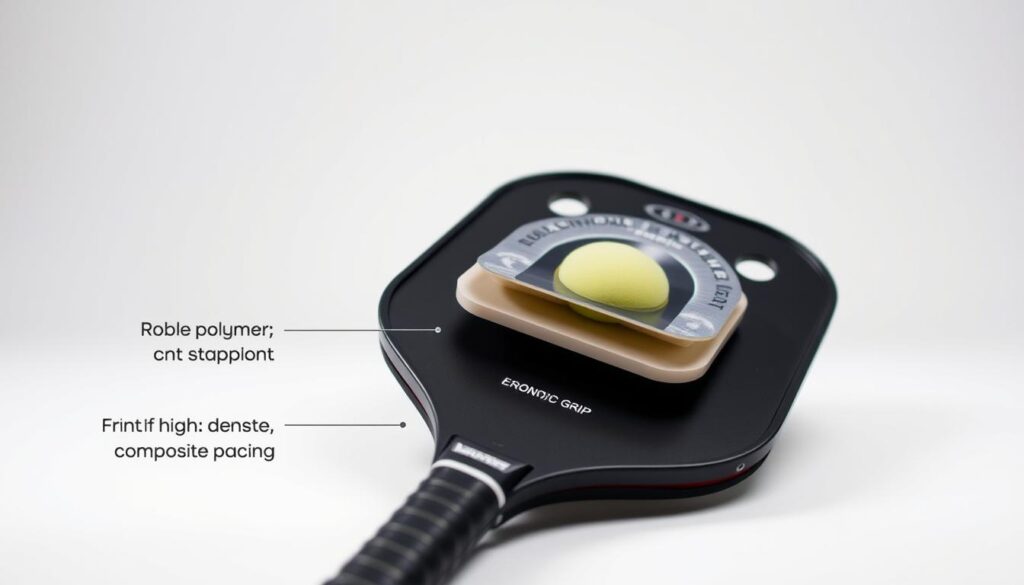
Choosing a paddle means considering its build. This affects how it feels and lasts. This guide explains common methods to help you find the right paddle. It’s a beginner’s guide to pick the best paddle for your game.
Cold pressed paddles have layers attached to a core with an edge guard. They offer a soft feel, great for touch shots. They’re also forgiving, perfect for beginners.
Light thermoforming adds foam around the edge, then heats and presses it. This creates a controlled paddle. It’s good for players who want control without a stiff feel.
Full thermoforming fuses faces with a carbon rim and foam walls. It’s firmer and more powerful. This style is great for drives and blocks, but might lose some softness.
Widened foam edge paddles have extra foam for a dual-wall effect. Brands like JOOLA made these popular. They offer more pop and stability, but feel can vary.
Full foam core paddles, introduced in 2025, use solid foam instead of honeycomb. They’re softer and more durable. Early reports suggest they last longer and play consistently.
Some paddles are forgiving, while others are more powerful. Cold pressed and light thermoformed paddles are forgiving. Full thermoforming and widened foam edge paddles are more powerful. Gen 4 foam cores aim to balance feel and durability, making them great for beginners.
Durability is key for long-term use. Some paddles age better than others. Cold-pressed and some light thermoformed paddles last long. Gen 4 foam cores seem to resist wear and tear, but time will tell.
This guide helps you compare paddles by feel and durability. Use it when testing paddles to find one that supports your learning and comfort.
Comfort, Grip Size, and Ergonomics for Longer Play
Playing pickleball for a long time means comfort is key. A paddle that fits your hand well and cushions shock is a must. It protects your wrist and elbow. Use this guide to find the right grip size, vibration control, and handle shape for you.
How to choose grip size based on hand size and common recommendations
To find your grip size, measure from the middle crease of your palm to the tip of your ring finger. Most beginners need between 4.0 and 4.5 inches. Smaller hands usually need 4.0″, average hands 4.125–4.25″, and larger hands 4.5″.
Try grips in-store when you can. Brands like Selkirk and Onix let you test the circumference and feel. Choosing the right grip size prevents over-gripping and reduces fatigue during long rallies.
Vibration, shock absorption, and features that protect wrists and elbows
Polymer honeycomb cores absorb shock better than some alternatives. Paddles with foam layers or perimeter inserts cut down vibration in your hand. Some models claim to reduce shock significantly, making long play easier without discomfort.
Look for cushioned wraps, silicone pads in the handle, or replaceable grips. An affordable beginner pickleball paddle with good damping can save your forearm. It lets you focus on technique instead of pain.
Handle length, grip taper, and how they affect control at the net
Shorter handles make quick net exchanges easier. Longer handles are good for two-handed backhands and alternate grips. For example, a 5.5″ handle is great for players who want a two-handed option on wider paddles.
Taper and profile affect how the paddle feels in your hand. A tapered handle helps with quick wrist action at the kitchen line. Choose a shape that fits your volleying style and how often you switch grips.
Ergonomic features to prioritize
- Replaceable grips that let you fine-tune thickness and tack.
- Cushioned wraps for extra shock absorption during long sessions.
- Silicone or foam inserts to manage vibration without adding heavy weight.
- Lightweight handle materials that reduce swing fatigue.
| Attribute | What to look for | Why it matters |
|---|---|---|
| Grip circumference | 4.0″–4.5″ range, test in-store | Prevents over-gripping, reduces wrist/elbow strain |
| Shock absorption | Polymer cores, foam layers, perimeter inserts | Minimizes vibration, extends comfort during play |
| Handle length | Short for maneuverability, 5.5″ or more for two-handed strokes | Impacts net control and shot variety |
| Grip replaceability | Removable wraps and cushioned overlays | Customize feel, prolong useful life of an affordable beginner pickleball paddle |
| Handle taper | Moderate taper for quick wrist action | Improves fine control at the kitchen line |
This guide helps you balance comfort with other important factors. Try different grip sizes, handle lengths, and damping levels. Find what lets you play longer without pain.
Beginner pickleball paddle Reviews and What to Look For
You’re looking for reliable reviews to choose the right pickleball paddle. Look for detailed testing, specific specs, and honest feedback from players. Reviews that share swingweight, static weight, and tear-down details are most helpful.
How to evaluate review reliability
Check if the reviewer measured swingweight, twistweight, and static weight. Look for on-court drills and feedback on how it feels. Be wary of reviews that seem biased due to brand ties. Choose reviews that compare several paddles side by side.
Which specs reviewers emphasize
Reviewers often highlight swingweight and twistweight. These numbers tell you about stability and control. They also talk about sweet spot size and core thickness, which affect forgiveness and power.
Examples cited in reviews and why they work
Reviews often mention the Rally Tyro 2 for its light weight and easy swing. The Paddletek Phoenix LTE and Tempest Wave are praised for their balanced cores and consistent play. The Selkirk NEO is noted for its simple design and reliable feel.
Paddles like the PIKKL Hurricane Pro get detailed reviews. It has a special carbon face and foam walls for a wider sweet spot. Despite being pricey, around $159.99, it’s known for its soft feel and forgiveness.
Value versus premium features
Paddles in the $50–$100 range offer great control and forgiveness for beginners. Premium paddles add features like thermoforming and advanced materials. These can improve your game but cost more. Reviews help you decide if the extra features are worth the price.
Quick checklist when reading reviews
- Are swingweight and static weight listed and measured?
- Did the reviewer test on-court with simple drills?
- Is sweet spot size and core thickness discussed?
- Do comparisons include Rally Tyro 2, Paddletek, Selkirk, or PIKKL models?
- Is any brand sponsorship disclosed?
By following this checklist, you can find the best beginner pickleball paddle. Look for reviews with detailed data, real-world testing, and fair comparisons. This will help you choose the right paddle for your game.
Price, Value, and When It Makes Sense to Invest More
Choosing a paddle depends on how often you play and what you need. An affordable beginner pickleball paddle works well for casual games. But, spending more is wise if you play often or want durable features.
In the $50–$100 range, you get reliable paddles. They have polymer cores, composite or fiberglass faces, and good grips. These are perfect for those who play a few times a month.
At $100–$160, you see better materials and construction. You’ll find carbon or refined layups and tighter tolerances. This range is great for those who play weekly, offering durability and a consistent feel.
Over $160, you find premium paddles. They have raw carbon, advanced construction, and pro-level features. Brands like PIKKL offer models here with features like replaceable skins. This is for serious players who want a paddle that grows with their skills.
What to expect in each price band
Here’s a quick guide to match your needs with your budget. Think about how long you’ll use it, its feel, and if you’ll upgrade soon.
| Price Range | Typical Materials | Who it’s best for | Key benefits |
|---|---|---|---|
| $50–$100 | Polymer core, fiberglass or composite face | Casual players, new learners | Low cost, forgiving, usable grip sizes |
| $100–$160 | Higher-grade carbon, refined layups, some thermoforming | Regular players, weekend competitors | Better feel, improved durability, smoother response |
| $160+ | Top-grade carbon, full foam cores, replaceable skins | Ambitious beginners, intermediates, frequent players | Pro-level sweet spot, longevity, customizable parts |
When a pricier paddle helps your progression
Playing often means you’ll see small improvements from better materials. A paddle with a thermoformed carbon face gives better feedback. This can help you learn faster, especially for dinks and third-shot drives.
Buying a paddle built to last can save you from upgrading too soon. Higher-end paddles have a wider sweet spot and steady swingweight. These features help you practice consistent technique without gear flaws.
Cost-saving options to stretch value
Replaceable skins let you refresh the hitting surface without buying a new paddle. Brands offer these skins at a low cost. Swapping a worn grip is even cheaper and can improve control and comfort.
Buying used from trusted sellers is another way to save. Look for delamination and handle wear. A well-maintained used paddle can perform like new for many more sessions.
When shopping, compare features, not just price. Focus on what matters for your game. This way, you’ll find the best beginner pickleball paddle that fits your budget and ambition.
How to Test and Compare Paddles Before You Buy
Find a paddle that matches your game and helps you get better. Start with a quick test to see how the paddle feels, its balance, and how it handles shots. Use a checklist to compare different paddles and avoid being swayed by fancy packaging or marketing.
When trying paddles, follow a simple checklist. First, check the static weight. Hold the paddle still and then do a few light volleys to see if it’s light enough for quick shots and long play.
Next, test the balance by doing short dinks and full swings. This will help you feel if the paddle is too heavy or just right. Also, check the grip size and texture. You should be able to adjust the grip and add tape if needed.
Look at spec sheets to back up your feelings. Focus on the core material and thickness, like 14mm versus 16mm. Also, check the static weight and swingweight if available. Twistweight helps judge stability on off-center hits.
Material and construction tell you about the paddle’s pop and durability. Ignore vague promises of “perfect balance” without numbers. Tech names mean little without the specs to back them up.
Run simple drills to test each paddle. Do a dink exchange at the kitchen line to judge touch and control. Hit a third-shot drive or baseline drive to test pop and stability.
Run a short rally focusing on spin to feel how the surface holds spin. Try off-center hits to check forgiveness and sweet spot size. This will help you see how the paddle handles different shots.
Compare paddles side by side using the same drills. Record any differences you notice. If you want more context, check swingweight and twistweight from reviews or databases. This will help you make a fair comparison.
| Test Point | What to Do | What It Reveals |
|---|---|---|
| Static Weight | Hold, volley, and volley for a minute | Comfort for long play; suitability for quick volleys |
| Balance / Swingfeel | Short dinks then full swings | Head heaviness, swingweight, and tempo control |
| Grip Size & Feel | Change grips, simulate tape additions | Comfort, wrist control, ability to use two-handed shots |
| Surface Texture | Spin-focused rally and serve attempts | Spin potential, consistency, and feel on contact |
| Sweet Spot / Forgiveness | Mishit drill with off-center shots | How the paddle handles errors and the effective sweet spot |
| Spec Sheet Check | Compare core thickness, static weight, swingweight | Objective match to your feel and long-term goals |
After testing, read user feedback and expert reviews. This will help you see how the paddle performs in real play. Use this information to choose a paddle that fits your style. When you have a few finalists, compare them closely to find the best fit.
Conclusion
Choosing the right beginner pickleball paddle is about a few key things. Look for the right material and thickness, a good weight and feel, and a shape that’s easy to use. Also, make sure the grip feels comfortable.
These features help you learn faster and play longer without getting tired. Use the guide above to find the best paddle for you, not just fancy marketing.
Start with a paddle that’s around 16mm thick and made of polymer or Gen 4 foam. Choose a widebody or hybrid shape and a grip that’s 4.0–4.25″. Try out paddles in person and use the guide’s drills to test them.
For a budget-friendly option, a $50–$100 polymer-core paddle is great for beginners. If you play a lot and want to improve fast, spend $100–$160+ on a thermoformed carbon or full foam paddle. These options last longer and are better for frequent players.
With the right priorities and testing steps, you can find the perfect paddle. Read the specs carefully, avoid false claims, and choose a paddle that meets your needs and keeps the game exciting.
